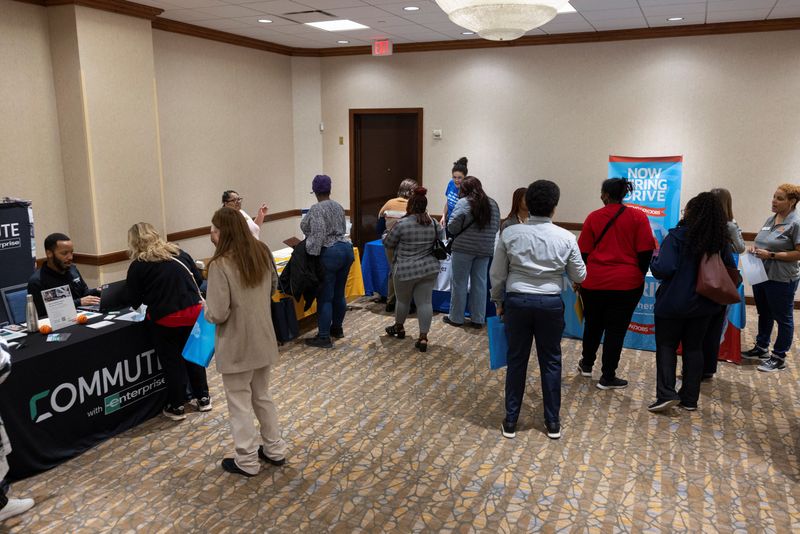
By Dan Burns
(Reuters) -The number of Americans filing new applications for unemployment benefits ticked up to the highest level in a month last week, suggesting the labor market was largely stable even though job creation is weakening and it is taking laid-off workers longer to find new employment.
Initial claims for state unemployment benefits for the week ended August 2 rose 7,000 to a seasonally adjusted 226,000, the highest level since the week ending July 5, the Labor Department said on Thursday. Economists polled by Reuters had forecast 221,000 claims for the latest week.
The labor market has slowed, with government data last week showing far fewer jobs were created in July than economists had expected as uncertainty over President Donald Trump's tariffs left businesses wary of adding workers. Moreover, employment gains in the previous two months were revised lower by nearly 260,000, a stunning reversal that prompted Trump to fire the head of the Bureau of Labor Statistics - a move that rattled investors and economists already anxious about the eroding quality of official U.S. economic data.
The latest data on new claims indicates employers are not yet turning to large-scale layoffs as the economy loses steam but are managing through attrition. That has helped keep the unemployment rate, at 4.2% in July, relatively low even while job growth has slowed. Declining labor supply amid the White House's immigration crackdown is also helping to stave off a jump in the jobless rate.
Employers' hesitancy to increase hiring means there are fewer jobs for those being laid off. The number of people receiving benefits after an initial week of aid, a proxy for hiring, rose to a seasonally adjusted 1.974 million during the week ending July 26, the claims report showed. That was the highest level of so-called continued claims since November 2021, and the increase of 38,000 from the previous week was the largest since late May.
Despite the rise in both new and ongoing claims last week, economists note the two continue to remain largely range-bound and have not exhibited the kind of breakout upswing that in the past has signaled a deteriorating job market. Indeed, the weekly net change in new claims has remained below 10,000 - in either direction - for 10 straight weeks, the longest such streak in about three years.
"The sideways drift in initial and continuing claims in recent months suggests that layoff activity is muted," Thomas Simons, chief U.S. economist at Jefferies, wrote in a note. "The 'no hire/no fire' theme in the labor market remains firmly intact."
That said, continued claims had been averaging less than 1.9 million until early May and in the three months since have averaged about 40,000 higher at about 1.94 million. That reset now makes more sense to some economists in light of the historic downward revision to the job creation figures for May and June that were revealed by BLS last week.
"The level of continued claims is still signaling that unemployed workers are finding it tough to find a job in a labor market where hiring is slow," Nancy Vanden Houten, lead U.S. economist at Oxford Economics, wrote. "Moreover, the steep rise in claims since April makes more sense following the sharp downward revisions to job growth in May and June and the sluggish pace of hiring in July."
PRODUCTIVITY REBOUNDS
Meanwhile, the Labor Department also said worker productivity rebounded more than expected in the second quarter, easing a surge in labor costs at the start of the year.
Nonfarm business sector productivity increased 2.4% in the April-June period after declining by 1.8% in the first three months of the year, BLS reported. Economists polled by Reuters had expected productivity to rise by 2.0%.
Worker output increased by 3.7%, the largest improvement since the third quarter of 2023, while unit labor cost growth moderated to 1.6% from an upwardly revised 6.9% in the first quarter. The data may be indicative of ongoing investments by businesses in labor-saving technologies like artificial intelligence, economists said.
"Productivity growth is settling back into its historical trend after bouncing around because of the pandemic," said Oren Klachkin, financial market economist at Nationwide. "Looking ahead, businesses will likely invest in labor-saving technologies to cap their wage bills, which should exert downward pressure on inflation. Companies facing the greatest labor constraints will likely be the most incentivized to invest."
(Reporting by Dan Burns; Editing by Paul Simao)

 Reuters US Domestic
Reuters US Domestic
 Associated Press US News
Associated Press US News America News
America News FOX 5 DC
FOX 5 DC Raw Story
Raw Story Orlando Sentinel Politics
Orlando Sentinel Politics NECN Providence
NECN Providence The Motley Fool
The Motley Fool